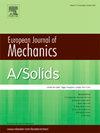Efficient feature extraction for morphologically complex self-assembled porous microstructures using computational homology and unsupervised machine learning
IF 4.4
2区 工程技术
Q1 MECHANICS
引用次数: 0
Abstract
Porous microstructures formed during the self-assembly process exhibit complex morphologies that directly influence their material properties. This study proposes an efficient method for microstructural parametrization, specifically designed for these complex structures. The method effectively combines computational homology and unsupervised machine learning techniques to achieve this goal. Computational homology is a technique that analyzes topological spaces by examining "holes" of different dimensions. Therefore, it is particularly effective for the morphological analysis of random and heterogeneous porous microstructures. In this regard, computational homology is used to extract simpler disjoint regions within the microstructure. convolutional autoencoder, k-means clustering, and other quantitative analyses are employed to analyze these regions as grayscale images.
A microstructure may consist of numerous disjoint regions. To efficiently represent these regions in a lower-dimensional space, a convolutional autoencoder is used. K-means clustering is then applied to group the low-dimensional representations of these disjoint regions based on morphological similarity. By clustering the microstructural regions, we can analyze the microstructures more efficiently and interpretably. Each disjoint region belongs to a cluster, and the microstructure is thus represented by low-dimensional features, indicating the percentage of disjoint regions in each cluster. To enhance interpretability, the feature orders are sorted based on their correlation with relative density. The correlation analysis revealed that the proposed microstructural representation features are interpretable, as the majority of features exhibit correlations with material properties such as Young's modulus and Poisson's ratio as well as topological features such as Betti numbers.
The proposed method is computationally efficient due to its low-dimensional representation of the microstructure and is interpretable, with features sorted and organized based on their correlation with relative density. To demonstrate its efficiency, numerical experiments were performed on microstructures created during the spinodal decomposition process. The results show that the method is effective for computational tasks such as material properties prediction and inverse design.
求助全文
约1分钟内获得全文
求助全文
来源期刊
CiteScore
7.00
自引率
7.30%
发文量
275
审稿时长
48 days
期刊介绍:
The European Journal of Mechanics endash; A/Solids continues to publish articles in English in all areas of Solid Mechanics from the physical and mathematical basis to materials engineering, technological applications and methods of modern computational mechanics, both pure and applied research.

 求助内容:
求助内容: 应助结果提醒方式:
应助结果提醒方式:


